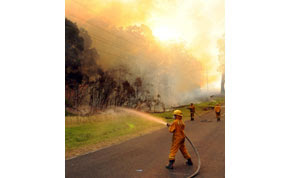The Australian newspaper has a very interesting, lengthy article about how the “Black Saturday” fires developed and were fought–including some behind the scenes activities in the “war room”. Here is an excerpt.
BACK in the war room, no one knew what had happened in Wandong. They had been alerted to the existence of the fire at Kilmore East but it was one of many fires that had suddenly sprung up around the state and were demanding their attention.
There was a new one near Bendigo, one near Beechworth, one near Coleraine, another near Horsham and reports of one near the community of Churchill in Gippsland in the state’s east, near to where arsonists had lit several recent fires.
Even so, Waller, Rees and Esplin say they had a sense of dread early on about the Kilmore fire. “I knew that was a dangerous place for a fire,” Esplin says. ‘A lot of tree changers had moved into areas around there and it is difficult fire-fighting country. I had a feeling of ‘Here it comes’.”
Waller says: “As soon as we saw that Kilmore fire, in a very short time we knew we had a real problem. It was running towards populated areas. You could run a ruler along where it was going to run – you knew straight away.”The ruler along the map showed the fire was heading directly for Kinglake.
What the war room did not yet fully understand was that this fire was behaving like none other they had experienced. It was much faster, much larger and was behaving more like a series of fireballs than a cohesive fire.
The combination of steep hills – which can double fire speed – with howling winds and a temperatures in the mid-40s were turning the Kilmore fire into a monster.
From this moment, and for the rest of what would become known as Black Saturday, the bulk of the CFA’s fire warnings being relayed on ABC radio trailed the reality on the ground. They came too late to alert many of the communities in its path.
no one was watching the progress of the East Kilmore fire more closely that Jason Lawrence, the 35-year-old CFA incident controller at Kangaroo Ground, who was responsible for shifting fire trucks and tankers around those communities near Kinglake.
Almost immediately, Lawrence knew he was powerless to do anything. “It moved through with such ferocity that there was nothing the local brigades could do,” Lawrence says.The size and speed of the blaze meant decisions about the deployment of fire trucks would have to be made on the ground by each individual CFA town chief. But with the growing confusion about the fire’s progress, they were given no clear warnings of its arrival.
This was not how the system was supposed to work.











